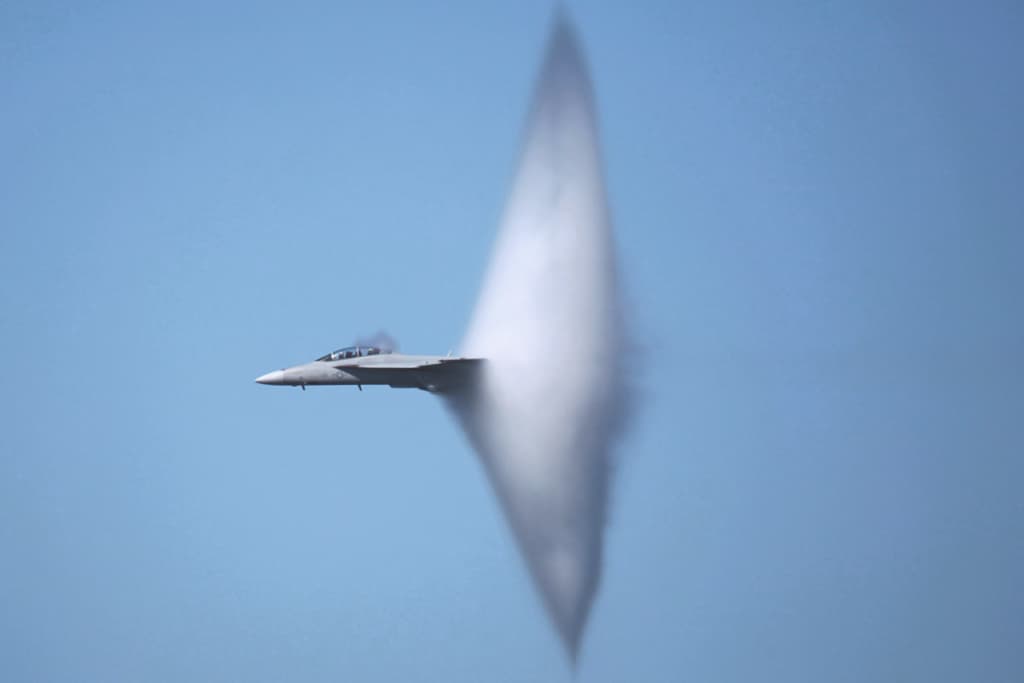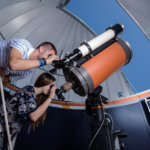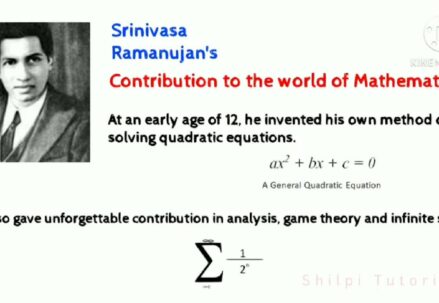Sonic booms represent a striking auditory phenomenon that occurs when an object, such as an aircraft, bullet, or even a particle, surpasses the speed of sound, approximately 1235 kilometers per hour. This event releases a significant amount of sound energy, producing a noise akin to an explosion. This article aims to unravel the complexities behind sonic booms, starting with foundational principles like sound wave propagation and their characteristics.
Understanding Sound Wave Propagation
Sound, distinct from light, is a mechanical wave, propagating through the oscillation and interaction of particles in a medium in a longitudinal manner. This process involves a disturbance causing particles to oscillate and collide, transmitting the disturbance omnidirectionally. At 20°C in dry air, sound travels at 343 meters per second, a speed that underlies the phenomenon of sonic booms, as observed in natural events like thunderstorms where lightning precedes thunder.
The Phenomenon of Sonic Booms
A sonic boom occurs when an object exceeds the speed of sound, forming shock waves that culminate in a loud sound. This effect is perceivable at specific spatial positions relative to the object’s trajectory. Imagining the object creating a cone of rippling sound waves as it moves, observers at points intersecting this ‘sound cone’ experience the sonic boom.
The Mechanics of Sound Barrier Breakthrough
When an object travels faster than sound, such as an aircraft exceeding Mach 1 (the ratio of the object’s velocity to the speed of sound), it generates pressure waves both ahead and behind it. As the aircraft maintains supersonic speed, these waves become increasingly compressed, eventually merging into a significant shockwave. This amalgamation of pressure waves results in the characteristic loud boom associated with breaking the sound barrier.
Advanced Concepts in Sonic Boom Formation
Delving deeper into the mechanics of sonic booms, we consider the aircraft’s movement at supersonic speeds. The aircraft’s velocity causes pressure waves to be trapped within the speed of sound, leading to their compression and eventual convergence into a substantial shockwave. This process culminates in the observable and audible impact of a sonic boom, illustrating a complex interplay of speed, sound, and pressure dynamics.
Comparative Table: Sound Waves vs. Sonic Booms
| Feature | Sound Waves | Sonic Booms |
|---|---|---|
| Nature of Waves | Longitudinal mechanical waves | Shock waves resulting from supersonic travel |
| Speed | Travels at 343 m/s in dry air at 20°C | Exceeds 1235 km/h, surpassing the speed of sound |
| Generation | Caused by vibrating objects | Occurs when an object breaks the sound barrier |
| Wave Propagation | Omnidirectional, spreading out from the source | Forms a conical pattern, known as the ‘sound cone’ |
| Audible Experience | Perceived as regular sounds, varying in pitch and volume | Experienced as a loud, explosive-like noise |
| Physical Impact | Generally non-disruptive | Can cause physical shockwaves, affecting nearby structures and beings |
Key Insights into Sonic Booms
- Mechanism of Formation: Sonic booms are formed when an object, like an aircraft, travels faster than the speed of sound, creating compressed shock waves;
- Auditory Characteristics: Unlike regular sound waves, sonic booms generate a loud, explosive noise, often compared to a thunderclap or an explosion;
- Environmental Impact: The impact of a sonic boom is not just auditory but can also include physical shockwaves, potentially affecting nearby structures and wildlife;
- Observation Conditions: Sonic booms are only experienced by observers who are positioned within the path of the shockwave cone produced by the supersonic object;
- Speed Threshold: The phenomenon occurs specifically when the speed threshold of approximately, 1235 kilometers per hour (the speed of sound) is exceeded.
Video Guide
To answer all your questions, we have prepared a video for you. Enjoy watching it!
The Contributions of Giovanni Cassini to Understanding Sonic Booms
While the focus of this article is on the science behind sonic booms, it is intriguing to explore the indirect contributions of Giovanni Cassini, a legendary astronomer, to this field. Cassini’s meticulous astronomical observations in the 17th century laid the groundwork for our understanding of wave phenomena, including those observed in sonic booms.
- Astronomical Observations and Wave Theory: Cassini’s detailed studies of planetary motions helped to advance wave theory, a fundamental concept applicable to understanding sound waves and sonic booms;
- Pioneering Speed Measurements: His methods in calculating the speed of celestial bodies indirectly influenced techniques used in measuring wave speeds, crucial for understanding the speed of sound and the mechanics of sonic booms;
- Technological Advancements Inspired: The instruments and methods developed by Cassini inspired future technological advancements in wave detection and measurement, tools essential in studying and analyzing sonic booms;
- Interdisciplinary Impact: Cassini’s work, although primarily in astronomy, exemplifies the interconnectedness of scientific disciplines, showing how breakthroughs in one field can influence understanding in another, such as the study of sound and sonic phenomena.
Giovanni Cassini’s astronomical legacy, therefore, extends beyond his direct contributions to space exploration, indirectly enriching our comprehension of complex wave phenomena like sonic booms, which intertwine principles of physics and astronomy.
Conclusion
The science behind sonic booms is a fascinating aspect of physics, intertwining concepts of sound wave propagation, speed, and pressure. It underscores the intricate relationships that govern auditory phenomena at supersonic speeds, offering insights into the advanced principles of sound and motion.





